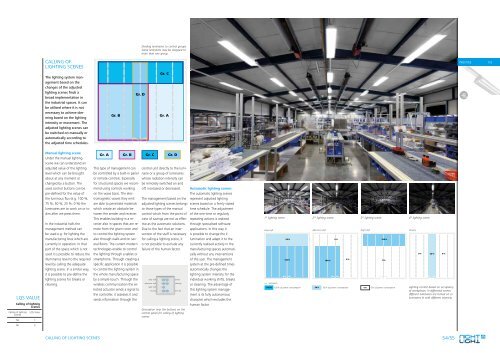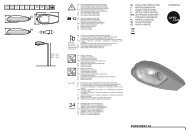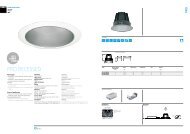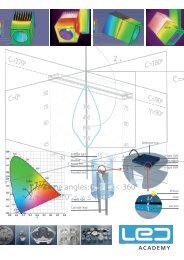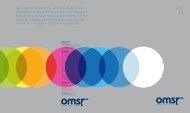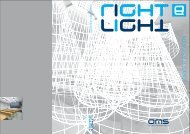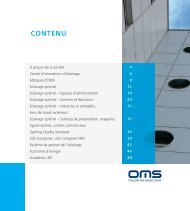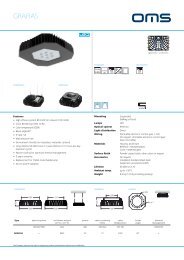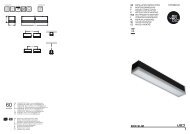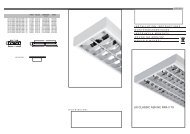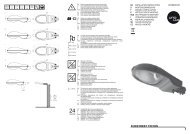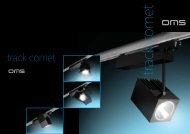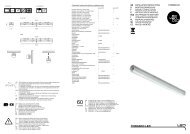Download PDF Catalogue - OMS lighting
Download PDF Catalogue - OMS lighting
Download PDF Catalogue - OMS lighting
Create successful ePaper yourself
Turn your PDF publications into a flip-book with our unique Google optimized e-Paper software.
Dividing luminaires to control groups.<br />
Some luminaires may be assigned to<br />
more than one group.<br />
CALLING OF<br />
LIGHTING SCENES<br />
PRESTIGE 152<br />
The <strong>lighting</strong> system management<br />
based on the<br />
changes of the adjusted<br />
<strong>lighting</strong> scenes finds a<br />
broad implementation in<br />
the industrial spaces. It can<br />
be utilised where it is not<br />
necessary to achieve dimming<br />
based on the <strong>lighting</strong><br />
intensity or movement. The<br />
adjusted <strong>lighting</strong> scenes can<br />
be switched on manually or<br />
automatically according to<br />
the adjusted time schedules.<br />
Gr. B<br />
Gr. D<br />
Gr. C<br />
Gr. A<br />
LQS VALUE<br />
Calling of <strong>lighting</strong><br />
scenes<br />
Calling of <strong>lighting</strong><br />
scenes<br />
LQS Value<br />
Yes 1<br />
No 0<br />
Manual <strong>lighting</strong> scene<br />
Under the manual <strong>lighting</strong><br />
scene we can understand an<br />
adjusted value of the <strong>lighting</strong><br />
level which can be brought<br />
about at any moment or<br />
changed by a button. The<br />
used control buttons can be<br />
pre-defined for the value of<br />
the luminous flux (e.g. 100 %,<br />
75 %, 50 %, 25 %, 0 %) the<br />
luminaires are to work on or to<br />
dim after we press them.<br />
In the industrial halls the<br />
management method can<br />
be used e.g. for <strong>lighting</strong> the<br />
manufacturing lines which are<br />
currently in operation. In that<br />
part of the space which is not<br />
used it is possible to reduce the<br />
illuminance level to the required<br />
level by calling the adequate<br />
<strong>lighting</strong> scene. In a similar way,<br />
it is possible to pre-define the<br />
<strong>lighting</strong> scenes for breaks or<br />
cleaning.<br />
Gr. A Gr. B Gr. C Gr. D<br />
This type of management can<br />
be controlled by a built-in panel<br />
or remote controls. Especially<br />
for structured spaces we recommend<br />
using controls working<br />
on the wave basis. The electromagnetic<br />
waves they emit<br />
are able to penetrate materials<br />
which create an obstacle between<br />
the sender and receiver.<br />
This enables building-in a receiver<br />
also in spaces that are remote<br />
from the given room and<br />
to control the <strong>lighting</strong> system<br />
also through walls and on several<br />
floors. The current modern<br />
technologies enable to control<br />
the <strong>lighting</strong> through a tablet or<br />
smartphone. Through creating a<br />
specific application it is possible<br />
to control the <strong>lighting</strong> system in<br />
the whole manufacturing space<br />
by a simple touch. Through the<br />
wireless communication the selected<br />
actuator sends a signal to<br />
the controller, it assesses it and<br />
sends information through the<br />
control unit directly to the luminaire<br />
or a group of luminaires<br />
whose radiation intensity can<br />
be remotely switched on and<br />
off, increased or decreased.<br />
The management based on the<br />
adjusted <strong>lighting</strong> scenes belongs<br />
to those types of the manual<br />
control which from the point of<br />
view of savings are not as effective<br />
as the automatic solutions.<br />
Due to the fact that an intervention<br />
of the staff is necessary<br />
for calling a <strong>lighting</strong> scene, it<br />
is not possible to exclude any<br />
failure of the human factor.<br />
daily shift<br />
afternoon shift<br />
night shift<br />
security<br />
service<br />
cleaning<br />
turn off<br />
Description near the buttons on the<br />
control panel for calling of <strong>lighting</strong><br />
scenes<br />
Automatic <strong>lighting</strong> scenes<br />
The automatic <strong>lighting</strong> scenes<br />
represent adjusted <strong>lighting</strong><br />
scenes based on a firmly stated<br />
time schedule. The adjustment<br />
of the one-time or regularly<br />
repeating actions is realised<br />
through specialised software<br />
applications. In this way it<br />
is possible to change the illumination<br />
and adapt it to the<br />
currently realised activity in the<br />
manufacturing spaces automatically<br />
without any interventions<br />
of the user. The management<br />
system at the pre-defined times<br />
automatically changes the<br />
<strong>lighting</strong> system intensity for the<br />
individual working shifts, breaks<br />
or cleaning. The advantage of<br />
this <strong>lighting</strong> system management<br />
is its fully autonomous<br />
character which excludes the<br />
human factor.<br />
1 st <strong>lighting</strong> scene: 2 nd <strong>lighting</strong> scene:<br />
3 rd <strong>lighting</strong> scene:<br />
4 th <strong>lighting</strong> scene:<br />
Daily shift<br />
luminaires<br />
50 %<br />
100 %<br />
Afternoon shift<br />
100 %<br />
Night shift<br />
100 % 100 % of power consumption<br />
50 % 50 % of power consumption<br />
0 %<br />
0 %<br />
0 %<br />
100 %<br />
0 %<br />
0 % of power consumption<br />
Security<br />
0 % 50 % 0 %<br />
Lighting control based on occupancy<br />
of workplaces. In differentd scenes,<br />
different luminaires are turned on or<br />
luminaires lit with different intensity.<br />
CALLING OF LIGHTING SCENES<br />
54/55


